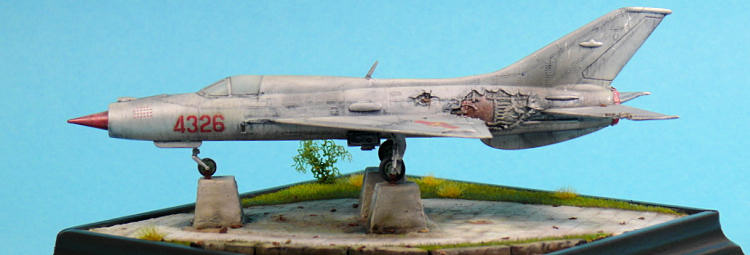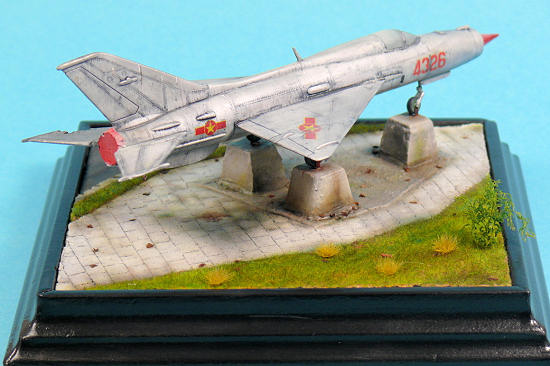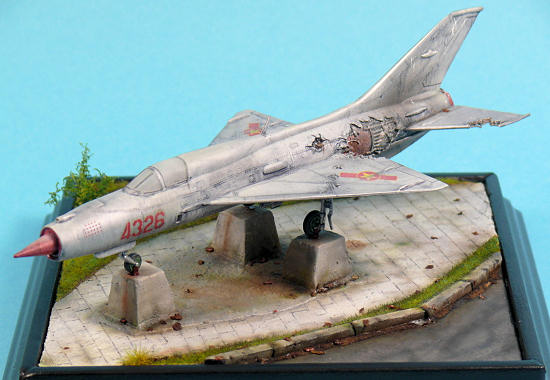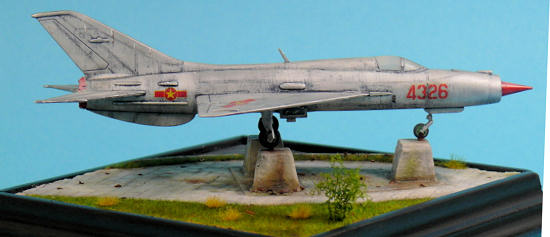
Lindberg 1/72 MiG-21 PF
| KIT #: | |
| PRICE: | $ |
| DECALS: | Two Options |
| REVIEWER: | Martin Pohl |
| NOTES: | Ex-IMC kit |

| HISTORY |
To write something on the history of the Mig-21 is a bit too much I’d
say as this plane is probably the most known Russian aircraft ever – so only
this:
The MiG-21, which initially became renowned during the Vietnam War, was
designed for very short ground-controlled i nterception
(
nterception
(
Although thirteen of North Vietnam's flying aces attained their status
while flying the MiG-21 versus just three in the MiG-17. Many North Vietnamese
pilots preferred the MiG-17, since the high wing loading of the MiG-21 made it
relatively less maneuverable, and the less heavily framed canopy of the MiG-17
gave greater visibility. However, this is not the impression perceived by
British author Roger Boniface when he interviewed Pham Ngoc Lan and ace Nguyen
Nhat Chiêu (who scored victories flying both MiG-17 and MiG-21) Pham Ngoc Lan
told Boniface that "The MiG-21 was much faster, and it had two ATOLL missiles
which were very accurate and reliable when fired between 1,000 and 1,200 yards”
and Chiêu asserted that "...for me personally I preferred the MiG-21 because it
was superior in all specifications in climb, speed and armament. The ATOLL
missile was very accurate and I scored four kills with the ATOLL. [...] In
general combat conditions I was always confident of a kill over a F-4 Phantom
when flying a MiG-21”.
| THE KIT |
This is an old probably a very old kit from the late 70ies or earlier.
I'm not sure whether Lindberg did the original forms or just reused some older
ones. You get what you can expect, raised panel lines and not that many parts
but then you get three extra parts, one fuselage half, one wing and one elevator
with battle damage. Well one could argue the battle damage does not look right,
but then it looks nice and different.
 The
very strange thing for that kit is, there is no interior at all – nothing – no
cockpit, just the canopy, that’s it. I did have some copied instructions and
those stated there should be a pilot figure and a piece formed like an “L”
representing a seat but still there is nothing mentioned about some cockpit
floor but I'm not sure if those instructions were the Lindberg ones. My copy did
not have any company label on it.
The
very strange thing for that kit is, there is no interior at all – nothing – no
cockpit, just the canopy, that’s it. I did have some copied instructions and
those stated there should be a pilot figure and a piece formed like an “L”
representing a seat but still there is nothing mentioned about some cockpit
floor but I'm not sure if those instructions were the Lindberg ones. My copy did
not have any company label on it.
| CONSTRUCTION |
So, when I
saw that there is nothing to put inside, I just decided to do something
different and that’s how this did come out.
As stated above the construction of the kit is not worth being mentioned
I just glued all parts together and filled the seams with milling wax.
So instead some words on the base perhaps. It’s made of Styrofoam where
the park is made of a layer of a mixture made of plaster and wall paint. You
sure could use plaster alone but that is drying within minutes rock hard. I
experimented a bit and found it very useful to mix some wall paint with water
until its like cream. In that I stir plaster until it’s like cold honey. This I
smear on to the foam and let I dry for an hour. It then is still easy to be
scratched with a needle or something to create the tiles. This then I put a way
for 2 days and then I start painting it. This mixture of wall paint and plaster
never gets that rock hard as plaster alone but it gets hard enough. The main
advantage is you have more time to form it.
| COLORS & MARKINGS |
 My kit
came with some Iraqi and Russian decals but I wanted a North Vietnamese
Mig-21 so I took some insignia from a Bilek kit.
My kit
came with some Iraqi and Russian decals but I wanted a North Vietnamese
Mig-21 so I took some insignia from a Bilek kit.
The plane got a base with Createx black base and then a coat of the
silver paint for heat pipes (or oven pipes) I’m often using for NMF. Then a
Future coat before the decals and after them. All the weathering is made with
very thinned oil paint (100:1 or 80:1 I never measured it) and some wood paint.
The damage areas were painted with acrylics and washed with oil colors. The last
touches like the bird placings are painted with oil color.
The base first got some static grass and then was treated with very
thinned oil paint and pastels until I thought it’s enough.
| CONCLUSIONS |
Yes, I know, a Mig-21 with this damage would never be able to land safe
– but, it looks different and that’s what I was looking for and then – you never
now :).
March 2012
If you would like your product reviewed fairly and fairly quickly, please contact the editor or see other details in the Note to Contributors.
Back to the Review Index Page 2023